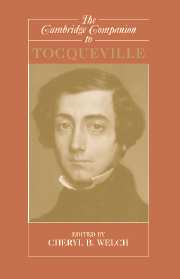Book contents
- Frontmatter
- Introduction: Tocqueville in the Twenty-First Century
- 1 Tocqueville’s Comparative Perspectives
- 2 Tocqueville on 1789: Preconditions, Precipitants, and Triggers
- 3 Tocqueville’s New Political Science
- 4 Tocqueville, Political Philosopher
- 5 Tocqueville’s Democracy in America Reconsidered
- 6 Translating Tocqueville: The Constraints of Classicism
- 7 The Writer Engagé: Tocqueville and Political Rhetoric
- 8 The Shifting Puzzles of Tocqueville’s The Old Regime and the Revolution
- 9 Tocqueville and Civil Society
- 10 Tocqueville on Threats to Liberty in Democracies
- 11 Tocqueville on Democratic Religious Experience
- 12 Tocqueville on Fraternity and Fratricide
- 13 Tocqueville and the French
- 14 Tocqueville and the Americans: Democracy in America as Read in Nineteenth-Century America
- Bibliography
- Index
- Series List
2 - Tocqueville on 1789: Preconditions, Precipitants, and Triggers
Published online by Cambridge University Press: 28 January 2007
- Frontmatter
- Introduction: Tocqueville in the Twenty-First Century
- 1 Tocqueville’s Comparative Perspectives
- 2 Tocqueville on 1789: Preconditions, Precipitants, and Triggers
- 3 Tocqueville’s New Political Science
- 4 Tocqueville, Political Philosopher
- 5 Tocqueville’s Democracy in America Reconsidered
- 6 Translating Tocqueville: The Constraints of Classicism
- 7 The Writer Engagé: Tocqueville and Political Rhetoric
- 8 The Shifting Puzzles of Tocqueville’s The Old Regime and the Revolution
- 9 Tocqueville and Civil Society
- 10 Tocqueville on Threats to Liberty in Democracies
- 11 Tocqueville on Democratic Religious Experience
- 12 Tocqueville on Fraternity and Fratricide
- 13 Tocqueville and the French
- 14 Tocqueville and the Americans: Democracy in America as Read in Nineteenth-Century America
- Bibliography
- Index
- Series List
Summary
INTRODUCTION
In his discussion of the causes of the English Revolution, Lawrence Stone distinguishes among preconditions (1529-1629), precipitants (1629-39), and triggers (1640-42). The preconditions ''made some form of redistribution of political power almost inevitable [ . . . ], but whether these changes would come about by peaceful evolution, political upheaval, or force of arms was altogether uncertain.'' Later, the ''precipitants of the 1630s turned the prospects of a political breakdown from a possibility into a probability,'' whereas the trigger was provided by ''a sequence of short-term, even fortuitous events which turned the probability into a certainty.'' The dates are of course somewhat arbitrary, but indicate points of inflexion in the likelihood that observers, whether writing at the time or with the benefit of hindsight, might assign to a revolutionary outcome.
One can try to make a similar distinction with regard to Tocqueville's writings on the French Revolution. The preconditions, discussed in Book II of the Ancien Régime (AR), were established over the period from 1439 to 1750. The precipitants, which are the topic of Book III, developed from 1750 to 1787. The triggering events, which are discussed in the notes for Books I and II of the planned second volume, occurred from 1787 to 1789. Although roughly adequate, this periodization is not quite true to his analysis, which points to a further inflexion point around 1770. In Ch.III.i of AR he points to 1750 (''vers le milieu du siècle'') as a watershed, marked by the appearance and intellectual hegemony of a certain kind of abstract philosophical radicalism.
- Type
- Chapter
- Information
- The Cambridge Companion to Tocqueville , pp. 49 - 80Publisher: Cambridge University PressPrint publication year: 2006
- 1
- Cited by



